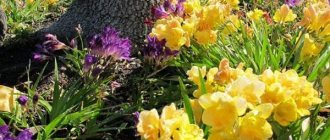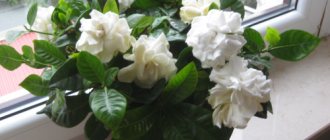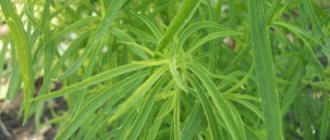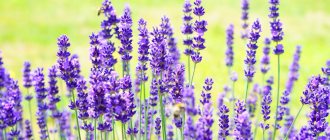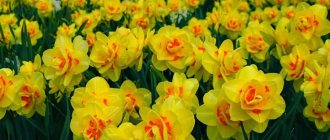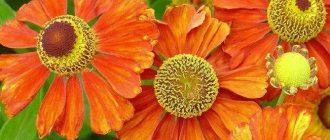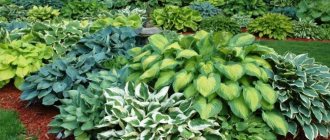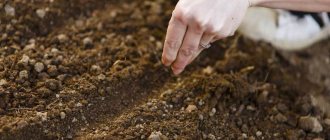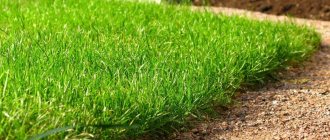Description of the plant
Daffodils are members of the amaryllis family. They are perennial herbaceous varieties and species.
The bud is placed on a bare peduncle of a slightly compressed or rounded shape. Depending on the species, the flowers can be collected in brushes or single, up to six centimeters in diameter.
Petals can be double or simple, snow-white or yellow. The perianth is distinguished by an elongated cylindrical tube with a cup-shaped, bell-shaped or tubular crown.
The seeds that are formed in the fruit are numerous. They quickly lose the ability to germinate.
This is one of those plants that can be found in almost every garden plot. Unpretentious and hardy, it does not require special care, grows quickly and blooms profusely.
Popular types and varieties of daffodils
Among the cultivated species and varieties recommended for planting in open ground, we can see those indicated in the table.
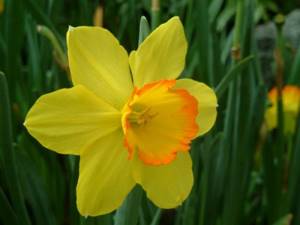
| Kinds | Brief characteristics | The most famous varieties |
| Large-crowned | They are distinguished by the largest size of the inflorescence, which consists of six buds, reaching 12 cm in diameter. The peduncle is single, tubular in shape, up to 0.5 m in height. Flowers - snow-white, orange, yellow | Record, Voa, Anthea |
| Small crown | The diameter of the inflorescences is no more than 8 cm. The color of the crown is yellowish-red, pink, white or scarlet with a greenish dot in the center | Chinese White, Amor, Ice King, Indiana Chief |
| Multifloral | More than eight buds can be collected on a peduncle, white, yellow or apricot in color with an orange crown. They tolerate shade well, but are not frost-resistant species. | Medusa, Elvira, Chefulness |
| Poetic | The inflorescence is solitary with a small crown and a tube, which is colored red along the edge. The peduncle reaches a height of 40-45 cm. The leaves are elongated and narrow, of a grayish tint. | Milan, Sarchedon, Actea |
| Split-crown | Due to the dissection of the crown and the fusion of six free leaves at the base, the impression is created of a second row of petals. The height of the peduncle is 11-12 cm. The color of the inflorescences is white, yellow and pinkish. They are light-loving and do not tolerate dark areas well. | Palmares, Baccarat, Cassata |
| Triandus | Miniature plants with a small crown that is shaped like a glass. The flowers are drooping, collected in inflorescences, or solitary. The color of the crowns is white, gold, yellow, sometimes with a greenish tint | Talia, Tresemble, Hawera |
| Tubular | The length of the crown is almost the same or even longer than that of the petals. Externally, they resemble a gramophone tube, and can reach 7-13 cm in diameter. White and yellow daffodils can be seen on the crowns | Maximus, Celebrity, Birshiba |
| Cyclamenoides | No more than 20 cm in height, similar in appearance to cyclamen. The flower is drooping, with one inflorescence with a long and elongated crown-tube. Blooms early, feels especially good on clay soils | Andalusia, Piping Tom |
Almost all of them are perfect for our climate. However, be sure to pay attention to frost resistance indicators and flowering duration.
Even more information about the types and varieties of daffodils:
Classification
Gardeners from different countries constantly compete with each other in developing new varieties of narcissus; everyone wants to surprise with extraordinary splendor or, on the contrary, grace of form and hitherto unprecedented colors. This has led to the fact that today's stock of registered varieties includes several hundred thousand items. The official registration of new varieties of daffodils is now carried out by the Royal Horticultural Society in London, but one can imagine how many unregistered varieties grow among amateurs in different countries. In order to have at least some guidance when choosing the narcissist of your dreams, we suggest that you familiarize yourself with the generally accepted classification.
- Trumpet daffodils have one large flower per peduncle. The perianth segments are the same length as the flower tube or slightly shorter. The color is most often white or yellow, and the tube and perianth may have the same or contrasting color. The classic proud shape of the flower is known to almost all people who are in one way or another connected with agriculture.
- Large-crowned daffodils - differ from the first group by a shortened crown (it occupies no more than half the length of the perianth petals). Simply put, the crown does not resemble the classic long “gramophone trumpet”, like in the varieties of the previous group, but is still clearly visible. Daffodils of this group have a slightly greater variety in color - the perianth can be pale yellow, white or cream, and the crown can be pink, red, orange and other colors. The shape of the crown can also be very different - corrugated, intricately bent, and even similar to airy lace.
- Small-crowned daffodils also have one flower on a peduncle, the crown of which never exceeds one-third the length of the perianth petals. The variety of colors and shapes is the same as that of the flowers of the second group. Two more differences - the flowering period begins a little later than in the first two groups, in addition, the plants grow much better.
- Double daffodils - their shape already resembles something like dahlias. A huge assortment of combinations of double and simple crowns and perianths of different colors and shapes provides an inexhaustible field for the imagination of breeders. When breeding them, you need to take into account one feature - if the flower head gets wet, then the peduncle can no longer withstand such a load. Flowers droop to the ground and often break. That is why such luxurious varieties of narcissus are often grown in greenhouses for cutting.
- Triandrus daffodils have two or more flowers on one peduncle. The flowers have a characteristic drooping (drooping) shape. The color of the flowers is lemon, golden, white. Excellent for planting in rock gardens.
- Cyclamen-shaped daffodils have an external resemblance to cyclamen flowers - the petals are very strongly bent back. Each peduncle contains only one flower, which has a narrow and long crown. The colors of the crown and petals of the perianth can be the same or contrasting.
- Jonquil daffodils have five to eight, and sometimes more, flowers on one peduncle. The crown is cup-shaped (width greater than length), and the perianth petals are spread out or slightly bent back. The colors are not particularly varied - different shades of yellow, sometimes white.
Planting daffodils in autumn and spring
You can plant bulbs at different times, but it is important to remember some of the features of each of them.
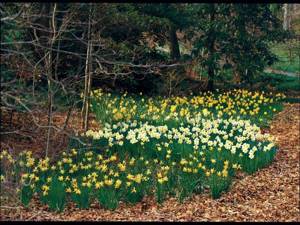
When planting, it is important to consider that:
- Planting in early autumn or late summer are the most preferable options. You can start from the beginning of August until mid-September. During this period, the growth of processes is activated;
- Planting daffodils in the spring is acceptable if planting in the fall was not possible. In order for it to be successful, the bulbs must be kept cool for several weeks. You can use a refrigerator (not a freezer!) for this. The best time for spring planting is mid-April and there is no point in delaying it.
- The optimal planting time is autumn, end of summer. However, do not despair if time has been lost; mid-spring is also quite suitable for planting.
Daffodils - planting and care
Narcissus, like the tulip, is an ephemeroid plant, that is, one that grows in spring and early summer. Its flowering is long-lasting and depends on the variety and weather conditions. By selecting varieties, you can extend the flowering period of daffodils to thirty days or more. Usually, in open ground they bloom in the second half of May.
Planting (reproduction)
Daffodils reproduce by bulb and baby. The most suitable areas for growing daffodils are those with light or medium loamy soils, with good drainage and where groundwater is at a depth of at least 60 cm. The soil must be cultivated, contain a lot of organic matter and have a neutral reaction.
If you live in the Middle Urals, then it is advisable to start planting in the second half of August. It is very important that the bulbs take root before the onset of persistent cold weather, otherwise they do not overwinter well and often die.
The optimal soil temperature for their rooting is 9 - 17 degrees. After planting, water the soil.
The planting depth depends on the mechanical composition of the soil and the size of the planting material. For example, bulbs of the first (diameter 4 or more cm) and second (diameter 3.9 - 3.0 cm) categories are planted at 12 - 15 centimeters, and children of the first (diameter 2.9 - 2.0 cm) and second (diameter less than 2.0 cm) categories are planted at 10 centimeters. On heavy soils the depth decreases.
The distance between the bulbs in the row for parsing is respectively 15, 10 - 12 and for children 8 - 10 centimeters.
When planting large material for growing cut plants for four to five years, the distance in the row between the bulbs of the first harvest is increased to 20 - 22 centimeters. Between rows it depends on the method of planting and care.
You can plant them in one line (between rows of 45 and 70 cm) and in two lines (between lines of 20 and ribbons of 50 cm). In small areas, planting is four to five lines (20 cm between rows) with a path width of 30 - 40 centimeters.
Where there is a lot of rainfall, daffodils are grown on ridges 12 - 20 cm high and 100 - 120 cm wide.
Caring for plantings includes a number of agrotechnical measures: mulching, fertilizing, watering, loosening the soil, controlling weeds, pests and diseases, and removing diseased plants.
During the growing season, daffodils consume a lot of water. Its deficiency reduces the intensity of their growth and size.
The soil should be moist even after the plants flower. During this period, the bulbs and children grow intensively and nutrients accumulate in them. The irrigation rate depends on the characteristics of the soil and its moisture content. During the growing season, plants are watered 2-4 times.
The soil is loosened starting in spring throughout the growing season, usually after watering or rain. In areas mulched with peat, the soil is loosened less often.
Pests of daffodils
Like all beautiful plants, daffodils also have pests:
- Onion root mite. It lives in the soil on plant debris and settles in planted bulbs. Develops at 23 - 25 degrees. At temperatures below 10 degrees and soil humidity below 60%, mite development stops.
Adult mites and larvae eat away the bottom and scales of the bulbs. Such daffodils do not grow. Pathogens of fungal and bacterial diseases settle on damaged tissues. In the fight against mites, it is necessary to destroy plant debris and carefully select planting material. It is effective to soak the bulb before planting in karbofos (0.5%) for 30 minutes.
- Onion and tuberculate hoverfly. The onion hoverfly is greenish-bronze. There are three semi-lunar light spots on the sides of the abdomen, body length 6.5 - 9 millimeters. The tuberculate hoverfly is similar in appearance and lifestyle to the onion hoverfly. The fly's years begin in June 0-July.
The female lays eggs in the soil and on the lower parts of plants. The larvae penetrate the bulb, overwinter in it and damage it. The fight against hoverflies is the same as against onion mites. During oviposition, the soil around the plants is watered with the same karbofos solution.
There are many legends about daffodil flowers. In all legends, the delicate flower is associated with water. So, in China it is called the flower of the “water god”. Here, daffodils give when they want to thank a person for their kindness.
Narcissus (narcissus) is a perennial bulbous, flowerbed, garden “prince” that belongs to the Amaryllis family. The name comes from the Greek concept “narkao” - to enchant, this is directly related to the excellent intoxicating aroma. Narcissus is widely used by gardeners in landscape design.
Growing daffodils in the garden: care rules
In order for flowers to grow healthy and delight you with a pleasant aroma and lush bloom, it is important to adhere to a number of rules.
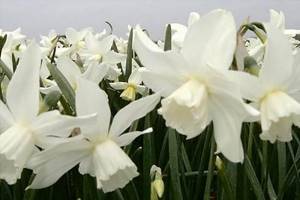
The main ones include:
- Regular watering and fluffing of the substrate; with the onset of summer heat, additional watering will be required;
- Application of annual fertilizers - they require two-time application of liquid fertilizers. The first is complex mineral nutrition during the formation of buds. The second is the application of fertilizer for flowering plants.
We invite you to watch a video about growing daffodils:
Following these simple rules will allow you to admire the abundant flowering and enjoy the pleasant aroma exuded by the flowers.
In addition, strong, healthy plants are more able to resist possible diseases or pest infestations.
Ice and fire
This bright composition is for emotional, passionate people. Suitable for a front flower bed in an open, sunny area. The attraction of color and aromas is difficult to overcome - such a flower garden will certainly be the center of attention.
Read also: Hydrangea paniculata: planting, care, cultivation
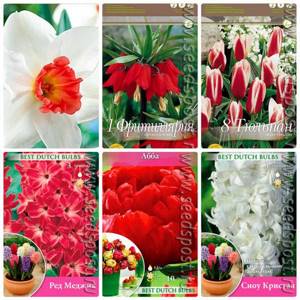
Ice and fire
But it’s not for nothing that they say that beauty requires sacrifice - you will have to take care of such a flower garden: dig up and dry the bulbs in time (except for daffodils, which do not need annual digging), and in September-October plant them again in loose, fertile, well-drained soil. The hyacinths included in the selection require light shelter for the winter.
All plants from this composition are suitable for cutting. They bloom at the end of April - the first half of May, flowering is long.
What's included in the collection:
- Large-crowned narcissus Perfect Lady, bulbs made in Holland, 5 pcs. packaged. Plant height is 40-50 cm.
- Imperial hazel grouse Rubra, made in Holland, 1 bulb per package. Plant height - up to 90 cm.
- Kaufman tulip Heart's Delight, bulbs made in Holland, 8 pcs. packaged. Plant height - up to 25 cm.
- Hyacinth Red Magic, 3 bulbs per pack. The height of the flowering plant is up to 25 cm. Fragrant.
- Early double tulip ABBA, 10 bulbs per package. Plant height 30-35 cm. Fragrant.
- Double hyacinth Snow Crystal, 5 bulbs per pack. The height of the flowering plant is up to 25 cm. Fragrant.
Diseases and pests
Although the plants are quite resilient, they can sometimes also suffer from diseases and pests.
| Pest or disease | Symptoms and signs | How to fix |
| Bottom rot, or fusarium | Starts from the bottom and spreads along the bulb | It is recommended to destroy all damaged bulbs and store healthy ones at a temperature not exceeding 18 C |
| Mosaic | Viral disease of leaves and flowers. It appears as green or yellow spots and leaf deformation. Transmitted in bulbs and through parasite bites | There is no treatment, affected plants should be destroyed |
| Hoverflies | The larvae of these flies penetrate the bulb and provoke its rotting. This can be noticed by a sharp stop in plant growth | Regular loosening and mulching is useful as a preventive measure. |
| Nematodes | Microscopic pests, damage to which manifests itself in the curvature of shoots and yellowing of leaves. To prevent it, before planting, it is recommended to dip the bulbs in water at 43.5 C | “Fitoverm” is suitable for treatment |
In order to prevent the death of affected plants, it is recommended to monitor their condition and, if alarming symptoms appear, treat them with appropriate medications.
If the problem cannot be eliminated in this way, it will be necessary to destroy the diseased plants, this will prevent the spread of the disease to healthy bushes.
Daffodils Flowerbed
Conditions
. They are photophilous, but tolerate planting well in partial shade, while blooming profusely and forming more bulbs. They prefer fertile, well-drained soils, from slightly acidic to neutral (pH 5.0-6.5). They grow poorly in marshy and calcareous areas. Moisture-loving. Relatively drought-resistant. Most varieties are winter-hardy and overwinter well under mulch. They are not afraid of light spring frosts during budding and flowering. They grow in one place for 3-5 years.
Landing
. The optimal time for planting bulbs is August or early September. It is advisable to prepare the area for planting one and a half to two months before planting. The earth is dug up to a depth of 30-35 cm, carefully removing weed roots, and humus is added at a rate of 15-20 kg/m². Manure can be applied no later than a year before planting. In two weeks, the soil is dug up shallowly again and superphosphate 50 g/m² and potassium salt 30 g/m² are added. Heavy soils with poor moisture permeability must be loosened with sand 20-30 kg/m² or peat 10-15 kg/m². Planted in groups or rows. The planting depth depends on the size of the bulb and is usually 12-15 cm. If you plan to dig up the bulbs every two to three years, the planting depth can be increased to 20 cm. The distance between plants is 10-20 cm, depending on the height. When planting in dry soil, water the area well.
Care
. Watering is advisable in dry weather during budding, flowering and for another 4-5 weeks after it. After watering or rain, the soil is loosened shallowly, combining this with weeding and fertilizing, and then mulched with dry soil or peat.
Daffodils respond very well to feeding. The first is carried out in the spring, as soon as the shoots appear, 100 g/m² of nitrophoska is added. The second is done during the budding period and the third during flowering. For these feedings, 60-70 g/m² of nitrophoska is sufficient. After flowering, fertilizing is done only with phosphorus-potassium fertilizers with an element ratio of 2:1. For these fertilizers, 50-60 g/m² is sufficient. Do not feed daffodils with fresh manure. Its presence in the soil contributes to the emergence of various fungal diseases and creates an optimal environment for bulb flies, mole crickets and beetle larvae.
If seed propagation is not planned, then it is advisable to remove faded flowers to improve the quality of the bulbs. For replanting, the bulbs are dug up as soon as the leaves turn yellow and fall. If you miss this moment, the bulbs will begin to take root again. The dug up bulbs are carefully washed, cleared of soil and plant debris, and sick, weak, and damaged ones are discarded. Then they are disinfected in a solution of potassium permanganate, dried in a ventilated area or under a canopy without direct sunlight and stored until planting. It is best stored at a temperature of about 17°C. Large bulbs can be set aside for forcing.
Many varieties of daffodils overwinter without any shelter, but some still need mulching with peat, a layer of leaves or straw about 8 cm thick. In harsh snowless winters, shelter is necessary for all daffodils. It is done after the onset of stable cold weather. In the spring, after the snow melts and before the growing season, the mulch layer is removed.
Of the pests, daffodils most often suffer from nematodes, narcissus flies and bulb flies. Diseases include fusarium, sclerotial rot and viral mosaics. As a preventive measure, we can recommend careful culling of planting material and adherence to the basic rules for storing, planting and caring for plants. Pre-planting treatments of bulbs with potassium permanganate infusion or heating them to 40°C for 12 hours have worked well. In the event of the appearance of diseases and pests, it is better to immediately remove infected plants and disinfect the soil where they grew.
Application
. Widely used in any flower beds, ridges, in group plantings on the lawn or between other plants. Many varieties can be grown in tree trunks and ornamental shrubs. Popular in spring bouquets. They grow well in containers and can also be used for winter or spring forcing.
Flowering, what daffodils look like in the photo
Depending on the species, daffodils in the photo may look different. The only thing that unites them is grace and beauty. Light tones of flowers turn any photo into a warm illustration of spring.
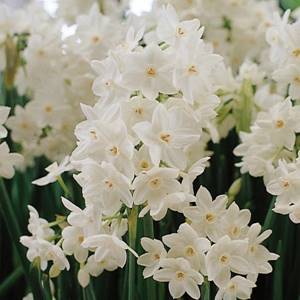
If some flowers in real life turn out to be far from being as good as in the image, then this option is excluded here. Both in life and in the image, they will delight you with the grace of lines and the unforgettable charm of light tones.
Narcissus: use in garden design
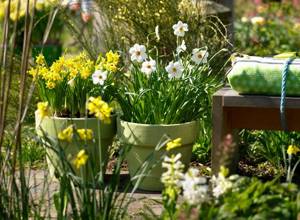

With the exception of exhibition gardens, the decorative effect of which is designed for a short time (as in the famous Dutch bulb park Keukenhof), daffodils are not planted in large tracts: after flowering, their foliage takes on a sloppy appearance, but does not die off completely for a long time, which can ruin a large-scale composition.
The classic way of planting daffodils in a flower garden is in groups of 5–7 bulbs in landscape compositions between clumps of perennials (geraniums, hostas, mantles and others). Partner plants should surround the group of daffodils on all sides, overlooking the flower garden. In late spring they grow back and almost cover the yellowing non-decorative foliage of the bulbous plants.
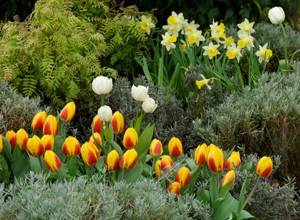
Miniature varieties can be planted in rock gardens. At the same time, there should be enough beautiful plants next to the daffodils to distract attention from the yellowing leaves in May.
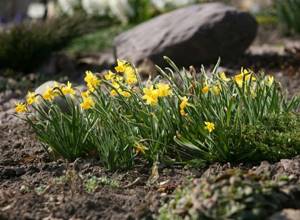
Any variety of daffodils is suitable for planting in containers.

After flowering, you can simply put the container in a secluded place and take care of the flowers there until they complete their development cycle.
(You can learn how to grow container plants in the article “Mobile flower beds”).
Tips for the designer
Do not try to use many varieties of bulbous plants of different flowering periods in one flower garden. The best impression will be made by the simultaneous flowering of 1–3 varieties of daffodils. If you are a beginner gardener, do not complicate your task - choose one unpretentious variety for your flower garden.
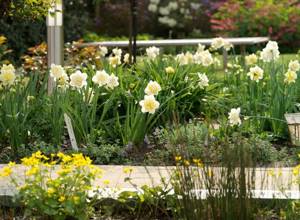
Test the selected varieties first in the garden and note their exact time of flowering in your garden, and then select partners for them and plan a flower garden.
In spring, the garden changes rapidly. Early daffodils bloom when the garden is dominated by bare soil, with few plants to keep them company.
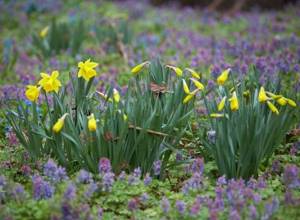
Late varieties bloom already in the midst of spring, when there is a lot of greenery and flowers in the garden. Therefore, the ideas for compositions with these varieties will be completely different.
Don't try to embrace the vastness and choose partners for daffodils so that the flowering does not stop all season. Such a flower garden will be boring because there will be few flowers in it at any given time. Feel free to rely on plants that bloom at the same time as daffodils.

Plant more small-bulbous crops (chionodoxa, snowdrops, crocuses and muscari) with the early varieties, and brunnera, bergenia, zhivochka, and primroses with the later varieties.
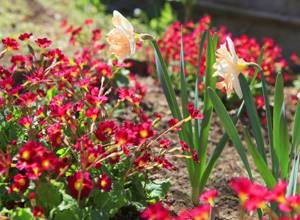
Enjoy the beautiful combination of colors to the fullest, and then let the flowering baton take over. another flower garden!
The florist, like an artist, carefully selects paints and creates paintings, not on canvases, but on flower beds of fresh flowers. Nowadays, people increasingly prefer beautiful flower beds at their dachas instead of traditional vegetable gardens. In this article we will look at how to choose the right plants to create flower beds in various styles.
Content:
Choosing plants for a flower bed
Choosing colors when creating flower beds
If you show your imagination and take into account the effect that different colors have on the human psyche, you can create flower beds that have a different character. And this is not a reservation.
- Flower beds grown in orange and red tones are exciting, and can even be somewhat annoying if you look at them for a long time.
- On the contrary, flower beds in blue and blue tones are calming. An orange-yellow flowerbed looks like a joyful bright sun, and even on cloudy days it will seem to illuminate the area.
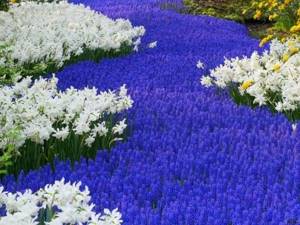
Usually, when creating flower beds, various combinations of colors are used, sometimes even contrasting ones, and a neutral white color is used to smooth them out. For example, the following combinations look very nice:
- red with yellow and green,
- purple with yellow,
- blue with orange.
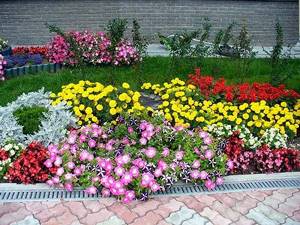
It all depends on the preferences of the gardener.
The influence of site illumination on the choice of plants
Depending on the lighting, flowers for flower beds of different colors look different.
- For example, flowers of blue, violet or blue color look faded in partial shade, but in the sun they look impressive.
- When choosing flowers for a flower bed, you need to remember that they should bloom at the same time if the flower bed is of a regular type. If an irregular flower bed is created, then the flowering of different species should occur sequentially one after another.
The choice of type of flowers largely depends on the location of the flower bed.
- Well-lit areas also require flowers that love to grow in the sun.
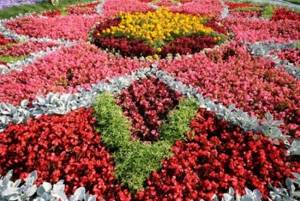
- Shade-tolerant plants, such as lilies of the valley, pansies and forget-me-nots, should be planted in a flowerbed located in partial shade. The perennial hosta plant also grows best in partial shade. Its decorative effect lies in the lush green, gray-blue or yellowish-variegated leaves edged with a light border.
- Unpretentious astilbe does not like bright sun. It has beautiful carved foliage and flowers in fluffy red, pink and white panicles.
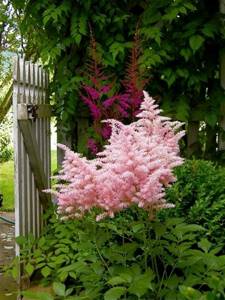
- When choosing flowers, it is necessary to take into account that some of them have different requirements for soil and watering, so it is better to plant flowers that are similar in their requirements in one flowerbed. For example, perennial plants, when fed with nitrogen, begin to “fatten”, that is, there will be a lot of leaves and almost no flowers, while bulbous plants, on the contrary, need nitrogen fertilizing.
Neighborhood of annual and perennial plants
In the same flower bed, many often plant perennials next to annuals and bulbous plants.
- The earliest flowering ones are bulbous ones, such as daffodils and tulips.
- Biennials begin to bloom in early June. At the same time, certain types of perennials bloom, for example, peonies and irises.
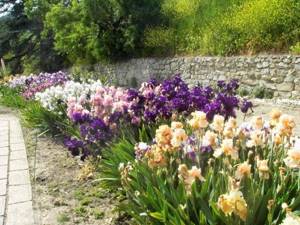
- Annuals bloom mainly in July and August.
Read also: How to plant and grow shadberry in your garden
The most common types of flower beds
Mixborder
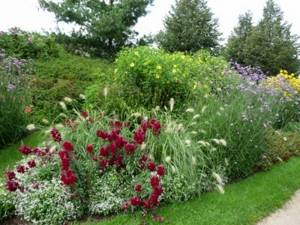
A mixborder is a flowerbed of irregular geometric shape.
- To create them, perennial and annual plants are used together, and in large-area mixborders, even shrubs and trees.
- Plants are selected so that flowering is continuous throughout the season. Also suitable are species with inconspicuous flowering, but with beautiful decorative leaves.
For example, in the center of a mixborder you can plant trimmed boxwood with wormwood, and behind them, decorative onions, verbena, polygonum and yarrow can be placed in groups. Frame the edge with geranium, mantle and cinquefoil. If the mixborder is located against a wall or fence, then red clematis will look good in the background.
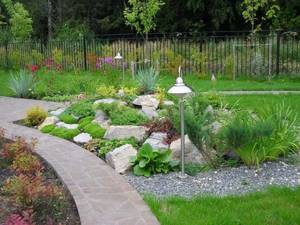
A rockery is a picturesque flowerbed among the stones of large boulders.
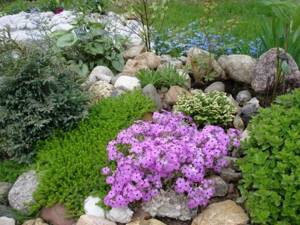
- Daffodils and tulips are also suitable for decorating a rocky flower bed. And ferns, heucheras and hostas will give it an elegant look.
- When purchasing any plants for rock gardens, you should definitely consult with specialists to see if they can grow in the specific conditions of a particular region.
Regular flower beds
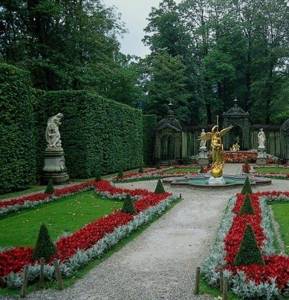
Flower beds that have strict geometric shapes are called regular flower beds.
- Low-growing annual, biennial and bulbous flowers are usually planted on them.
- A regular flowerbed needs to be looked after all the time, since no deviations from the original shape are allowed here, and growing plants strive to go beyond the outlined boundaries.
- Large open areas are decorated with regular flower beds. In summer cottages, such flower beds are extremely rare.
Vertical flower beds
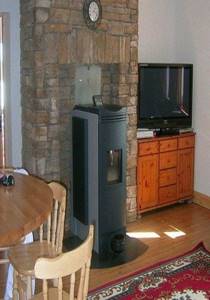
Vertical flower beds using climbing plants are very popular among gardeners.
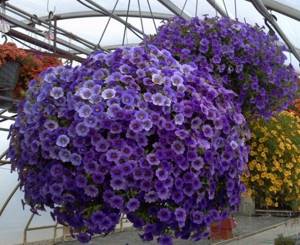
Edges and borders
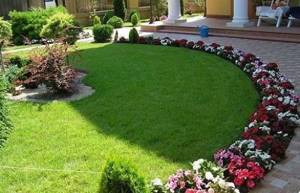
Along the garden path, wall or fence, long flower beds - edgings - are laid out.
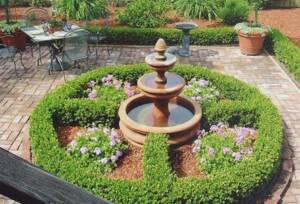
A flowerbed formed according to a strict geometric shape and forming a harmonious ensemble with a nearby building is called a parterre.
- The parterres are complemented by arabesques - flower beds made in the shapes of butterflies, flowers or any other. But creating such flower beds is very labor-intensive and expensive, so they are practically never found in dachas.
Group plantings
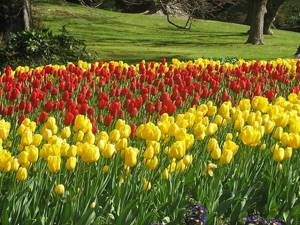
Many people, when creating landscape design on a site, use group plantings of flowers and other plants.
Multi-level flower beds
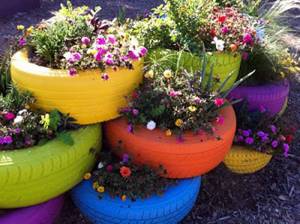
A popular design solution is to install raised multi-level flower beds, which are visible from any corner of the site.
- Skilled gardeners can create such stepped flower beds themselves from available materials, for example, from boards, bricks, car tires.
- You can place roses or phlox in the center, fill the middle level with light flowers of medium height, and plant low dark flowers on the lowest tier. It will be interesting if such a flower bed is made in one color, but with different shades.
Monoflowers

The best option for small areas are round or square monoflower beds, on which a specific type of flower is planted, for example, roses, dahlias or asters.
Irregular flower beds
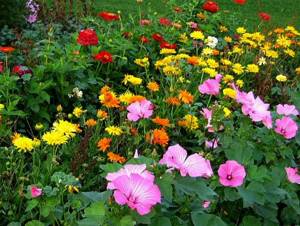
Irregular flower beds are perhaps most widespread among gardeners.
They do not have any strict rules for their design.
To create a unique landscape design on your site, you can combine different types of flower beds. When planning them, the best effect will be achieved by skillful selection of plants. The main principle of the gardener in this case is the desire for biological and harmonious unity of flowers for flower beds.
Caring for daffodils after flowering
Basic care for daffodils after flowering consists of several stages that should not be forgotten:
- Leaves should not be trimmed for several months;
- After the foliage has dried, it is not pulled out, but carefully trimmed;
- In winter, young flowers are covered with leafy turf or humus;
- It is recommended to dig up young bulbs once every three years, in mid-summer.
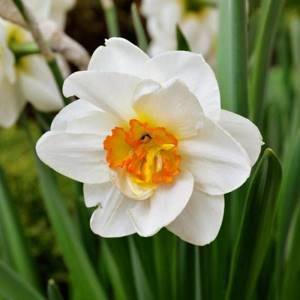
It is important to remember that the bulbs continue to breathe, so you should not keep the planting material out of the soil for more than two months.
Bulb storage
It is recommended to store the bulbs in a dry, well-ventilated place, in a container without soil. For added convenience, different varieties can be placed in different containers and labeled.
For three weeks, the bulbs are dried at a temperature of + 24 C. After this, the seed must be cleaned and divided. At this stage it is important not to damage anything. In addition, each bulb must be carefully checked for diseases or pests.
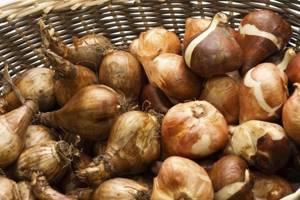
Children who fall away must be separated for subsequent placement. After this, the bulbs need to be put back into containers. The room temperature during subsequent storage should not exceed 10-17 C, and the humidity level should not exceed 75%.
Propagation of daffodils
Reproduction occurs in two ways: by seeds or by planting. The latter method is often used, separating the young bulbs from the mother. The vegetative method is suitable for plants older than three years. So, during this period, the upper scales have time to dry and it can be divided into several parts for subsequent planting.
Planting with seeds is not particularly common, but is done. To do this, it is recommended to sow ripened seeds that have not been dried. Flowering of such seedlings can be seen only in the fifth year.
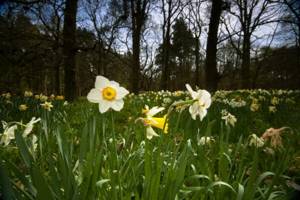
Depending on the experience of the gardener, you can choose any of the options. However, the second one still requires more skill.
The best varieties of the cut-crown group of daffodils
11. Split-crown - have an original crown split into several parts (usually 6). The height of the peduncles, depending on the variety, ranges from 25 to 50 cm, the diameter of the flower is 7-11 cm, the diameter of the crown is 2.5-10 cm. Currently, this group of daffodils occupies a special place due to the variety of flower shapes.
Based on the shape of the crown, there are 3 subgroups:
1) the crown fits tightly to the petals;
2) does not adhere to the petals along the entire length, the lobes are curved, notched along the edge;
3) resembles a six-rayed star with narrow lobes.
Varieties:
"Printle." The flower is 11.5 cm in diameter, the perianth is white, the crown is yellow with an unusually beautiful “curly” (fringed) edge. The shape of the flower resembles an orchid.
"Mondragon". The flower is 10.5 cm in diameter with a bright yellow perianth, the crown is dark orange, corrugated. Average, universal.
"Riesling". The flower is 9.5 cm in diameter, light lemon yellow, the crown is split almost to the base with a corrugated edge. Medium late. Mainly used for cutting.
"Royal Hayness". The flower is 10 cm in diameter with a white perianth, the crown is yellow-orange, curly, corrugated, with a wavy edge. Average, universal.
"Sunker." Flower with a diameter of 11.5 cm with a creamy-white perianth, an azalea-shaped crown, light cream with a wavy edge, with a diameter of 9 cm. Medium, universal.
Silver Shell. The flower is 10-11 cm in diameter with a white perianth, the crown is large (8.5 cm), soft cream, corrugated. Early, universal.
"Sovrin." The flower is 8-9 cm in diameter with a white perianth, the crown is bright orange, corrugated. Average, universal.
"Flyer". A very spectacular single-color bright yellow flower (11-12 cm), the crown is curly, corrugated with outgrowths. Mid-late, universal.
"Egard." The flower is 10.5 cm in diameter with a white perianth and a lemon-yellow crown. Late, universal.
"Etincelant". Flower 10 cm in diameter with a white perianth, azalea-shaped crown, creamy pink. Mid-late, universal.
Daffodils are hardy plants and rarely get sick. But sometimes they are affected by fungal, viral and other diseases. Gray rot causes rot of leaves and bulb necks. The bulbs become covered with a white coating and eventually rot without sprouting.
Beneficial features
In addition to beauty, these flowers are known for their beneficial medicinal properties. Thus, the alkaloids that are part of the flower are used to treat certain types of leukemia, radiculitis, polyneuritis, and muscle atrophy.
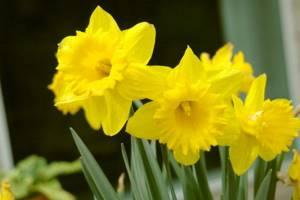
In alternative medicine they are used to treat male infertility. In addition, they are used in the manufacture of painkillers and for the prevention of mastitis in women.
The oil is used for relaxation and treatment of nervous diseases. But it is contraindicated in case of personal intolerance, and is not recommended for use by pregnant women and children.
Narcissus is not only an elegant garden decoration, but also a medicinal plant. It has been known and used since time immemorial in China and ancient Greece.
How daffodils are used in landscape design
Since the leaves of these flowers do not wither for a very long time, they are often paired with plants with lush foliage, which will help cover yellowed flowers and leaves. Therefore, you can often find hosta or mantle next to them.
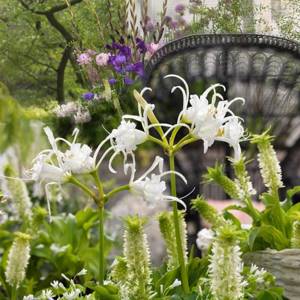
Planting is done in small groups of up to seven pieces, often combined with snowdrops or plants with later development periods - bergenia and primrose.
Used to frame borders, decorate alleys and alpine slides.
A well-chosen variety is an amazing decoration for a garden of any style. Designers willingly use the plant as an important component of many spring flower beds.
Growing daffodils in open ground is not a difficult process. Unpretentious and persistent plants require minimal effort in care, but they pay royally and generously for the attention they receive.
